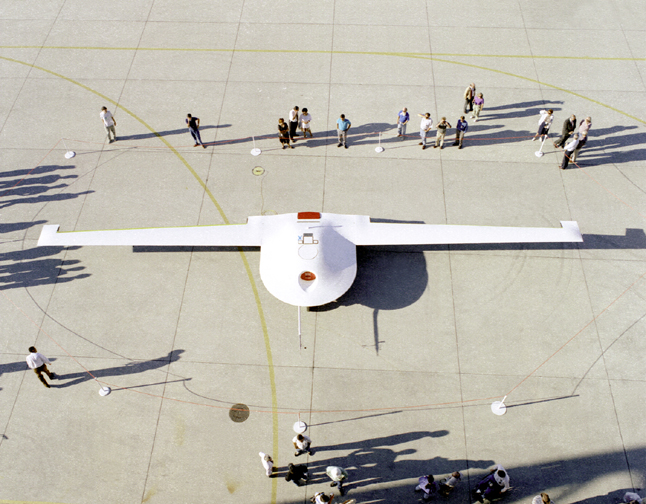Space History Photo: Tier 3 DarkStar on Ramp

In this historical photo from the U.S. space agency, the Lockheed Martin/Boeing Tier III- (minus) unpiloted aerial vehicle is inspected by NASA personnel September 14, 1995, following its arrival at the Dryden Flight Research Center, Edwards, California.
The Tier III Minus project utilized Dryden ground facilities during the flight test program. The vehicle was developed by Lockheed Martin Skunk Works and Boeing Defense and Space Group to satisfy a goal of the Defense Airborne Reconnaissance Office (DARO) to supply responsive and sustained surveillance and reconnaissance data from anywhere within enemy territory, day or night, in all types of weather. Dubbed DarkStar, it had a wing span of 69 feet and was designed to fly above 45,000 feet at subsonic speeds on missions lasting more than eight hours.
The first DarkStar prototype made its first flight on March 29, 1996. At the begininning of its second flight, on April 22, 1996, it crashed on takeoff, and was destroyed. The DarkStar's unusual shape was dictated by the requirement to orbit its target conducting surveillance while still remaining stealthy. Whereas aircraft like the F-117 are designed to be more stealthy from the front, the DarkStar is designed to be more stealthy from the sides.
Each weekday, SPACE.com looks back at the history of spaceflight through photos (archive).
Get the Space.com Newsletter
Breaking space news, the latest updates on rocket launches, skywatching events and more!
Join our Space Forums to keep talking space on the latest missions, night sky and more! And if you have a news tip, correction or comment, let us know at: community@space.com.

The National Aeronautics and Space Administration (NASA) is the U.S. government agency in charge of the civilian space program as well as aeronautics and aerospace research. Founded in 1958, NASA is a civilian space agency aimed at exploring the universe with space telescopes, satellites, robotic spacecraft, astronauts and more. The space agency has 10 major centers based across the U.S. and launches robotic and crewed missions from the Kennedy Space Center in Cape Canaveral Florida. It's astronaut corps is based at the Johnson Space Center in Houston. To follow NASA's latest mission, follow the space agency on Twitter or any other social channel, of visit: nasa.gov.
